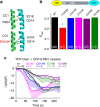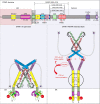A dual mechanism promotes switching of the Stormorken STIM1 R304W mutant into the activated state
- PMID: 29483506
- PMCID: PMC5827659
- DOI: 10.1038/s41467-018-03062-w
A dual mechanism promotes switching of the Stormorken STIM1 R304W mutant into the activated state
Abstract
STIM1 and Orai1 are key components of the Ca2+-release activated Ca2+ (CRAC) current. Orai1, which represents the subunit forming the CRAC channel complex, is activated by the ER resident Ca2+ sensor STIM1. The genetically inherited Stormorken syndrome disease has been associated with the STIM1 single point R304W mutant. The resulting constitutive activation of Orai1 mainly involves the CRAC-activating domain CAD/SOAR of STIM1, the exposure of which is regulated by the molecular interplay between three cytosolic STIM1 coiled-coil (CC) domains. Here we present a dual mechanism by which STIM1 R304W attains the pathophysiological, constitutive activity eliciting the Stormorken syndrome. The R304W mutation induces a helical elongation within the CC1 domain, which together with an increased CC1 homomerization, destabilize the resting state of STIM1. This culminates, even in the absence of store depletion, in structural extension and CAD/SOAR exposure of STIM1 R304W leading to constitutive CRAC channel activation and Stormorken disease.
Conflict of interest statement
The authors declare no competing financial interests.
Figures








Similar articles
-
Gain-of-Function Mutation in STIM1 (P.R304W) Is Associated with Stormorken Syndrome.Hum Mutat. 2014 Oct;35(10):1221-32. doi: 10.1002/humu.22621. Hum Mutat. 2014. PMID: 25044882
-
Functional analyses of STIM1 mutations reveal a common pathomechanism for tubular aggregate myopathy and Stormorken syndrome.Neuropathology. 2020 Dec;40(6):559-569. doi: 10.1111/neup.12692. Epub 2020 Oct 19. Neuropathology. 2020. PMID: 33073872
-
CRAC channels and disease - From human CRAC channelopathies and animal models to novel drugs.Cell Calcium. 2019 Jun;80:112-116. doi: 10.1016/j.ceca.2019.03.004. Epub 2019 Mar 11. Cell Calcium. 2019. PMID: 31009822 Free PMC article. Review.
-
A dominant STIM1 mutation causes Stormorken syndrome.Hum Mutat. 2014 May;35(5):556-64. doi: 10.1002/humu.22544. Epub 2014 Apr 9. Hum Mutat. 2014. PMID: 24619930
-
Gain-of-function mutations in STIM1 and ORAI1 causing tubular aggregate myopathy and Stormorken syndrome.Cell Calcium. 2018 Dec;76:1-9. doi: 10.1016/j.ceca.2018.07.008. Epub 2018 Sep 3. Cell Calcium. 2018. PMID: 30243034 Review.
Cited by
-
Conformational dynamics of auto-inhibition in the ER calcium sensor STIM1.Elife. 2021 Nov 3;10:e66194. doi: 10.7554/eLife.66194. Elife. 2021. PMID: 34730514 Free PMC article.
-
STIM1 activation of Orai1.Cell Calcium. 2019 Jan;77:29-38. doi: 10.1016/j.ceca.2018.11.009. Epub 2018 Nov 30. Cell Calcium. 2019. PMID: 30530091 Free PMC article. Review.
-
A luminal EF-hand mutation in STIM1 in mice causes the clinical hallmarks of tubular aggregate myopathy.Dis Model Mech. 2019 Dec 3;13(2):dmm041111. doi: 10.1242/dmm.041111. Dis Model Mech. 2019. PMID: 31666234 Free PMC article.
-
Environmental and Endogenous Acids Can Trigger Allergic-Type Airway Reactions.Int J Environ Res Public Health. 2020 Jun 29;17(13):4688. doi: 10.3390/ijerph17134688. Int J Environ Res Public Health. 2020. PMID: 32610702 Free PMC article. Review.
-
Mutations in proteins involved in E-C coupling and SOCE and congenital myopathies.J Gen Physiol. 2022 Sep 5;154(9):e202213115. doi: 10.1085/jgp.202213115. Epub 2022 Aug 18. J Gen Physiol. 2022. PMID: 35980353 Free PMC article. Review.
References
-
- Stathopulos P. B., Li G. Y., Plevin M. J., Ames J. B., Ikura M. Stored Ca2+ depletion-induced oligomerization of stromal interaction molecule 1 (STIM1) via the EF-SAM region: an initiation mechanism for capacitive Ca2+ entry. J. Biol. Chem.281, 35855–35862 (2006). - PubMed
Publication types
MeSH terms
Substances
Supplementary concepts
Grants and funding
LinkOut - more resources
Full Text Sources
Other Literature Sources
Medical
Miscellaneous

